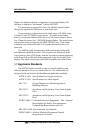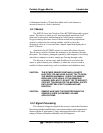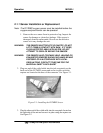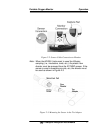
Portable Oxygen Monitor Introduction
Teledyne Analytical Instruments 13
is illuminated on the LCD and the audible and visual alarms are
activated whenever a fault is detected.
1.5.1 Sensor
The MX300-I uses the Teledyne Class R17MED disposable oxygen
sensor. The sensor is made up of a sensing cathode and anode (fuel)
immersed in electrolyte and packaged in a small plastic container.
Oxygen entering the sensor reacts with the anode and a proportional
current is collected at the sensing cathode, which is sent to the
electronics where it is converted into a digital signal and displayed on
the LCD Screen.
Attached to the R17MED sensor is a removable plastic diverter.
This diverter is used to facilitate the transport of gas mixtures through
the sensor. The diverter, packaged separately when shipped, is necessary
when the tee adapter is used to sample gas flowing through a tube.
The diverter is not necessary and should not be used when the
sensor is placed directly in a chamber, or when the sensor is used in
confined volume monitoring, such as incubators and inhalation tents.
CAUTION: THE R17MED SENSOR CONTIANS A CAUSTIC
ELECTROLYTE AND LEAD. DO NOT TRY TO OPEN
THE SENSOR ASSEMBLY. CHECK THE SENSOR
REGULARLY FOR LEAKS. IF THE SENSOR IS
LEAKING, REPLACE IT. DO NOT TRY TO REPAIR IT.
CONTACT TELEDYNE FOR THE MATERIAL SAFETY
DATA SHEET RELATED TO HANDLING AND
DISPOSAL.
CAUTION: REMOVE AND SAVE THE DIVERTER WHEN THE
SENSOR IS USED IN CONFINED VOLUME
APPLICATIONS.
1.5.2 Signal Processing
The electrical voltage developed in the sensor is sent to the electronics.
Processing includes amplification, conversion to digits, and comparison to
alarm set points if appropriate. Using a microprocessor allows for easier
setting of alarms, automatic calibration, and self-diagnosis.


















